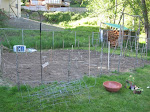a cross is in the courtyard for people to carry
Like other churches in the Holy Lands, it is shared by three denominations: Catholics, Greek Orthodox and Armenian Orthodox. Three other orthodox communities also have rights here: Coptic, Syriac and Ethiopian. Ethiopian monks live in a kind of African village on the roof. In order to maintain the peace, the Status Quo was established in 1757 by the Ottoman Turks. This ladder was there when the Status Quo began and must remain to this day, although it has disappeared twice thanks to pranksters and later found and replaced. There are a few stories about how it got there.
Inside, the church is a bustling maze of hallways, shrines, ornaments, and over 30 chapels and worship spaces.
Immediately inside the door is the stone that is venerated as the stone on which Christ's body was anointed for burial. The practice of kissing and rubbing cloths on the stone began in the 12th century, the stone dates from 1810. Behind the stone is a Greek mosaic of Christ being taken from the cross and buried.
To the right of the door are some stairs that go up to Calvary, or Golgotha. A little girl was quoted in 1951 as saying, "I never knew our Lord was crucified indoors." :)
To the left of the main entrance, is a large dome over a stone edicule over the tomb of Christ. Inside are two chapels. The first is the Chapel of the Angel and it contains what is believed to be a piece of the rolling stone that covered the entrance to the tomb. Then you go through a very low door into the chamber where the body of Jesus was laid. A cracked marble slab lies on top of the stone. The Fransicans cracked the marble slab in 1555, so that the Ottoman Turks would not steal it. We did not wait in the over 2-hour long line to get into the tomb, but we did take pictures from the outside...
visitors inside the tomb chapel
But it gave us time to explore some of the other places inside the church...
the central worship space in the church
































No comments:
Post a Comment